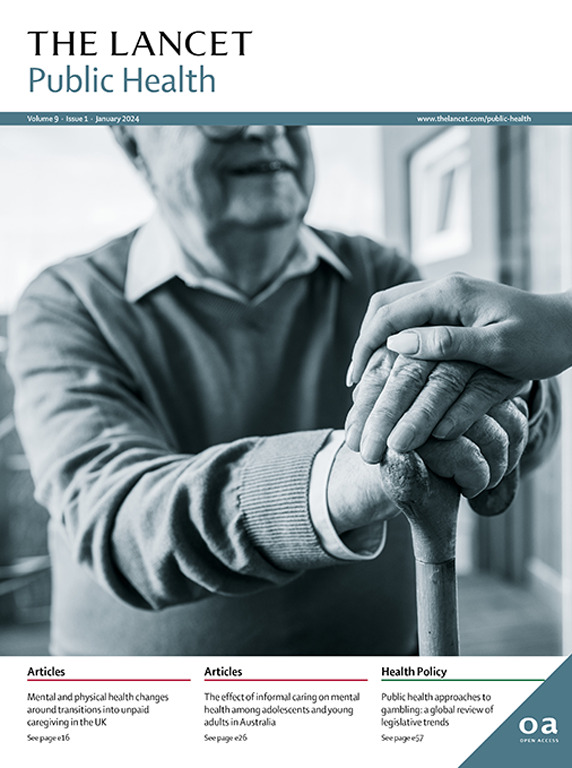Health benefits of leisure-time physical activity by socioeconomic status, lifestyle risk, and mental health: a multicohort study
IF 25.4
1区 医学
Q1 PUBLIC, ENVIRONMENTAL & OCCUPATIONAL HEALTH
引用次数: 0
Abstract
Background
Regular physical activity is recommended for all aged 5 years and older, but the health benefits gained might differ across population subgroups. The aim of this study was to examine these benefits in terms of years lived free from major non-communicable diseases in subgroups with varying levels of risk factors.Methods
Our analysis was based on a multicohort study of initially healthy European adults from the IPD-Work Consortium and initially healthy participants from the UK Biobank study. Self-reported leisure-time physical activity levels at baseline (1986–2010) were categorised as low (no or very little), intermediate (between low and recommended levels), and WHO-recommended (≥2·5 h of moderate or ≥1·25 h of vigorous physical activity per week). We divided the study population into 36 overlapping subgroups based on socioeconomic factors, lifestyle, and mental health at baseline, and assessed disease-free years between ages 40 years and 75 years for both the overall population and subgroups, accounting for coronary heart disease, stroke, type 2 diabetes, cancer, asthma, and chronic obstructive pulmonary disease.Findings
14 IPD-Work studies were assessed and six studies were excluded due to missing outcome data and unavailable data for pooling, resulting in the inclusion of eight studies with 124 909 participants. After the exclusion of 7685 participants due to prevalent diseases and 9265 due to missing data, the sample consisted of 107 959 initially healthy European adults (63 567 [58·9%] females and 44 392 [41·1%] males) from the IPD-Work consortium. For the UK Biobank sample, 9 238 453 million individuals were invited, 8 736 094 (94·6%) were non-respondents, and 502 359 participated in the baseline examination. After the exclusion of 73 460 participants, 428 899 participants had data on at least one measure of physical activity. 236 258 (55·1%) were female and 192 641 (44·9%) were male. During 1·6 million person-years at risk, 21 231 IPD-Work participants developed a non-communicable disease, while 101 319 UK Biobank participants developed a non-communicable disease over 4·8 million person-years at risk. Compared with individuals with low physical activity, those meeting the recommended physical activity levels during leisure-time gained an additional 1·1 (95% CI 1·0–1·2) to 2·0 (1·7–2·3) disease-free years, depending on sex and study. In males from the IPD-Work and UK Biobank cohorts, greater gains in disease-free years were observed in current smokers (2·4 [95% CI 2·1–2·8]) versus never smokers (0·7 [0·5–0·9]); those with low education (1·4 [1·1–1·7]) versus high education (0·8 [0·7–1·0]); low socioeconomic status (1·7 [1·5–2·0]) versus high socioeconomic status (0·9 [0·7–1·1]); and those with (1·6 [1·3–1·9]) versus without depressive symptoms (1·0 [0·9–1·1]; p value range <0·0001–0·0008). Similar differences were seen in women for smoking (2·3 [95% CI 1·9–2·7] vs 0·9 [0·7–1·1]), socioeconomic status (1·7 [1·4–2·0] vs 0·8 [0·5–1·0]), depressive symptoms (1·4 [1·1–1·7] vs 1·0 [0·9–1·1]), and for heavy drinkers compared with moderate drinkers (1·4 [1·1–1·6] vs 0·9 [0·7–1·1]; p value range <0·0001–0·010). No differences in physical activity-related health gains were observed between risk groups and non-risk groups by BMI, history of depression, and, in men, alcohol use (p value range 0·11–0·86).Interpretation
In addition to confirming the association between leisure-time physical activity and increased disease-free years across population subgroups, our findings show that these health benefits are often more pronounced among individuals with pre-existing health risks or disadvantaged backgrounds than in those with more favourable risk factor profiles. This suggests that enhancing population-wide physical activity initiatives could help reduce health disparities, while incorporating physical activity into targeted strategies addressing social disadvantage, unhealthy lifestyles, and depression might enhance their effectiveness.Funding
Wellcome Trust, UK Medical Research Council, US National Institute on Aging, and Research Council of Finland.求助全文
约1分钟内获得全文
求助全文
来源期刊

Lancet Public Health
Medicine-Public Health, Environmental and Occupational Health
CiteScore
55.60
自引率
0.80%
发文量
305
审稿时长
8 weeks
期刊介绍:
The Lancet Public Health is committed to tackling the most pressing issues across all aspects of public health. We have a strong commitment to using science to improve health equity and social justice. In line with the values and vision of The Lancet, we take a broad and inclusive approach to public health and are interested in interdisciplinary research.
We publish a range of content types that can advance public health policies and outcomes. These include Articles, Review, Comment, and Correspondence. Learn more about the types of papers we publish.
 求助内容:
求助内容: 应助结果提醒方式:
应助结果提醒方式:


